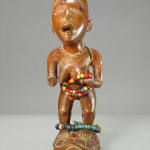Kongo Wooden Sculpture of a Woman Standing on a Tortoise, 20th Century CE
Wood
3.75 x 14.375
PF.4396
Further images
For an African artist the 'real' world has a different meaning than it does for those in the West. The existence of a spirit world is not in question. Nor...
For an African artist the "real" world has a different meaning than it does for those in the West. The existence of a spirit world is not in question. Nor is the interaction between spirits and living beings a matter of doubt. The barrier separating the tangible universe from intangible realms is very thin and easily penetrated. It was therefore crucial for specialists, such as sorcerers, to interpret signs, portents and omens, and deal with evil spirits. Just as it was important for artists to interpret the physical and metaphysical states of being in their work.
It was believed among the Kongo people (as with others) that statues could be used as objects of communication between spirits and the living. They functioned as "mediums" in which the spirit might inhabit or be attracted to in order to grant favors. For women it was of great importance to encourage fertility. A woman's status depended upon her having a child, and to promote this event, statuettes were made to invoke powerful forces which could influence conception and birth.
This particular example is marvelously expressive. The woman is in the throes of beseeching aid, most likely to help her to conceive and have an easy childbirth. Her breasts are very prominent, indicating both sexual desire and suckling of a child. The patterns on her body show scarification which indicates, as does the beads she wears, that this woman was from a wealthy family. An interesting feature is she stands on the back of a tortoise, an animal which lives in two worlds--land and sea, easily going from one to the other; as the spirit of this woman hopes to do in her yearning for a child.
It was believed among the Kongo people (as with others) that statues could be used as objects of communication between spirits and the living. They functioned as "mediums" in which the spirit might inhabit or be attracted to in order to grant favors. For women it was of great importance to encourage fertility. A woman's status depended upon her having a child, and to promote this event, statuettes were made to invoke powerful forces which could influence conception and birth.
This particular example is marvelously expressive. The woman is in the throes of beseeching aid, most likely to help her to conceive and have an easy childbirth. Her breasts are very prominent, indicating both sexual desire and suckling of a child. The patterns on her body show scarification which indicates, as does the beads she wears, that this woman was from a wealthy family. An interesting feature is she stands on the back of a tortoise, an animal which lives in two worlds--land and sea, easily going from one to the other; as the spirit of this woman hopes to do in her yearning for a child.







